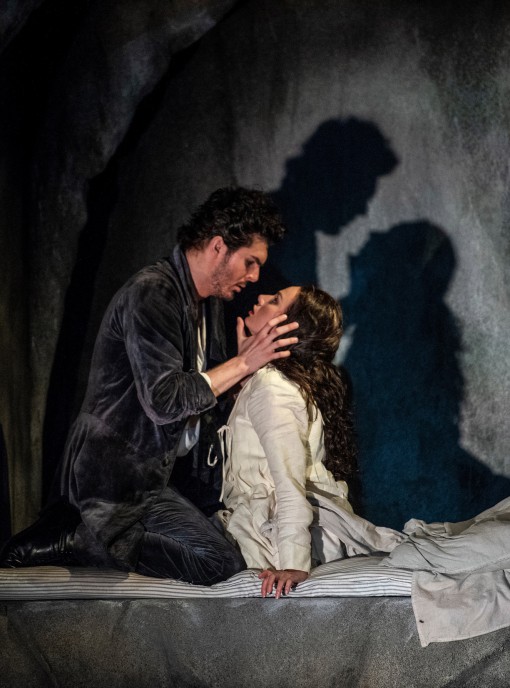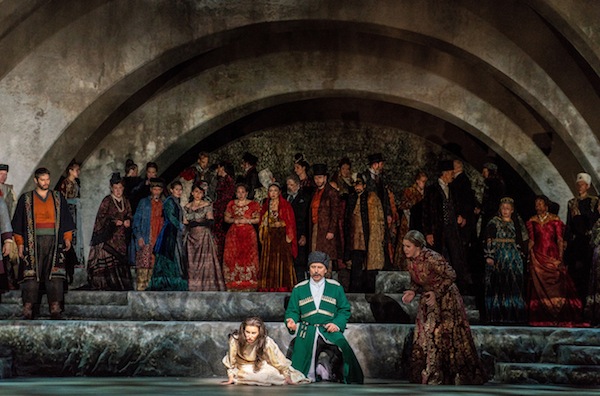Bard SummerScape explores fifty shades of grey in Rubinstein’s bleak “Demon”

Efim Zavalny and Olga Tolkmit in Anton Rubinstein’s “Demon” at Bard SummerScape.
Photo: Stephanie Berger
Too bad the lunar eclipse was not visible in the Hudson Valley on Friday night. The blood-red moon would have made a perfect backdrop for the opening of Russian composer Anton Rubinstein’s opera Demon at Bard SummerScape. The weather compensated with a lightning-punctuated tempest, harmonizing with the video projections of drenching rain that launched this striking new production by Thaddeus Strassberger.
The opera is a rarity, at least in the United States, but it should not be. The eponymous wicked spirit spurns his Creator’s love for a woman’s more full-blooded passion. He torments a princess in the Caucasus with secret visions, killing her fiancé and seducing her even within the walls of the convent to which she tries to escape.
For all the supernatural elements, the demon is a recognizable type, the tortured Byronic anti-hero. Mikhail Lermontov, author of the overheated but classic source poem, was “married to a hefty volume of Byron,” as his cousin once put it.
A cast of Russian singers ensured consummate ease with the musical style and Russian pronunciation, although some singers stood out for their sheer power.
Soprano Olga Tolkmit was hardly a fragile damsel as Tamara, molding the expressive potency of her voice into a haunting performance. High notes at soft dynamics sometimes eluded her, but when needed her top range wailed like a bloodcurdling siren.
The Demon of baritone Efim Zavalny could have used more of that force. Strassberger’s use of a handful of identical supernumeraries, who made the Demon appear to teleport around the stage, amplified Zavalny’s magnetic stage presence, at one point crouching on Tamara’s chest like the incubus in Henry Fuseli’s painting The Nightmare. Even so, the major climaxes of the score missed the mark without more savage snarl from the lead character.
The best performances came further down the cast list, beginning with the Angel of mezzo-soprano Nadezhda Babintseva. A guardian figure who does a poor job of protecting Tamara, her voice imposed itself like a blade from all corners of the stage. Video projections of a winged shadow and an aureole of light (designed by Greg Emetaz and JAX Messenger, respectively) only magnified the effect of her admonitory tone.
Alexander Nesterenko’s heroic tenor made one truly regret the early exit of his character, Prince Sinodal, murdered by the Demon in Act I. A dashing figure in long hair and long cape (costumes by Kaye Voyce), Nesterenko elicited great beauty from the character’s love song, one of the most gorgeous pieces in the opera. (Strassberger here added a nice touch by having Tolkmit appear as a ghostly vision visiting the Prince in his dreams.)
Bass Andrey Valentii resonated with paternal gravitas as Gudal, Tamara’s aged father, and the luxury casting continued with puissant mezzo-soprano Ekaterina Egorova in the minor role of the Nanny.
Director Strassberger needlessly complicated the narrative structure by showing the commitment of Tamara to the convent at the end of the initial chorus, actions then repeated where they are supposed to occur in Act II. He thus cast the story largely as Tamara’s paranoid delusions, giving the impression of an insane princess being cared for by the nuns.
A backdrop of concentric arches evoked the barren gray of the convent, where Tamara and other nuns slept fitfully in an arcade of monastic cells that rolled on and off stage (sets by Paul Tate dePoo III). By contrast, riots of color appeared in Tamara’s demented memories: flower petals flung up by the sisters washing laundry and especially the lavish wedding scene, overhung by images of rich rugs and tapestry.
Leon Botstein conducted the American Symphony Orchestra, choosing to perform the complete score including the exotic wedding ballet. In choreography by Shorena Barbakadze, the Pesvebi Georgian Dancers–acrobatic men with swords and bucklers matched by mysterious women floating in white dresses and red veils–captured the wild spirit of the Caucasus, the region between the Black Sea and Caspian Sea that so fascinated Lermontov.
For all his musicological rigueur, Botstein’s conducting was not always clear, leading to some ensemble disagreements between pit and platform. The Bard Festival Chorale, well prepared by James Bagwell, also had trouble following Botstein’s beat at times, but they acquitted themselves nobly in the demanding choral parts. The ASO’s bus reportedly arrived late because of traffic, prompting a ten-minute delay to the start of the show, but they negotiated the long evening with skill, some intonation smudges in the strings aside.
Rubinstein’s use of glass harmonica, signaling the Demon’s soul-disturbing spiritual power in Act II, echoes Donizetti’s use of the instrument in Lucia, though here it was often awkwardly out of tune with the doubling flute. Touches of percussion, including the evocative “iron gong” of the watchman heard in Act III, rounded out a fascinating, compelling web of sound.
Demon continues through August 5. fishercenter.bard.edu; 845-758-7900
